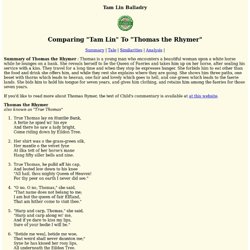

Thomas the Rhymer. Thomas of Erceldoune, sometimes styled Thomas Learmonth (fl. c. 1220 – 1298;[1]), was a 13th-century Scottish laird and reputed prophet from Earlston (then called "Erceldoune"),[2] and known by the sobriquets Thomas the Rhymer or True Thomas.

[a] In literature he appears as protagonist to the tale about Thomas the Rhymer who was carried off by the "Queen of Elfland" and returned having gained the gift of prophecy, as well as the inability to tell a lie. The tale survives in a medieval verse romance in five manuscripts, as well as in the popular ballad "Thomas the Rhymer" (Child Ballad number 37).[3][4] The original romance ca. 1400 was probably condensed into ballad form ca. 1700, though there are dissenting views on this. Historical figure[edit] Thomas the Rhymer. Thomas the Rhymer Feature Page on Undiscovered Scotland. Thomas the Rhymer, lived from 1220 to 1298.

He was a Scottish laird with a reputation for prophesy and supernatural powers. The wider picture in Scotland at the time is set out in our Historical Timeline. Thomas the Rhymer - Scotland's Stories. Do you believe in fairies?

Friends of Thomas. Origins of Thomas the Rhymer and the Queen of Elfland. Thomas Rymer. A Is one of the nine ballads transmitted to Alexander Fraser Tytler by Mrs Brown in April, 1800, as written down from her recollection. 1 This copy was printed by Jamieson, II, 7, in his preface to 'True Thomas and the Queen of Elfland.' B, never published as yet, has been corrupted here and there, but only by tradition.

C being compounded of A and another version, that portion which is found in A is put in smaller type. Thomas the Rhymer. Thomas the Rhymer, was a famous Scottish prophet who is also known as Thomas of Ercildoune, Lord Learmont and True Thomas.

There can be no doubt that he was actually a real person living in the thirteenth century, as documents exist signed by him as Thomas Rymour de Ercieldoune. It is difficult to find any more evidence about his life, but the traditions that have built up around him must have some root in real events. There are many accounts of his prophecies printed in chapbook form from the sixteenth century onwards.
It is said that he gained his powers of prophecy from a meeting with the Queen of Elfland. He travelled with her for forty days and forty nights into the underworld, and served her for seven years. One of his most famous prophecies involved the crowning of James the VI of Scotland or the I of England. Thomas is said to have returned to fair Elfland. This is a role he serves with other figures such as the Reverend Robert Kirk and archetypal figures such as Merlin.
"Tam Lin" And "Thomas the Rhymer" Tam Lin Balladry Summary | Tale | Similarities | Analysis | Summary of Thomas the Rhymer : Thomas is a young man who encounters a beautiful woman upon a white horse while he lounges on a bank.

She reveals herself to be the Queen of Faeries and takes him up on her horse, after sealing his service with a kiss. They travel for a long time and when they stop he expresses hunger. She forbids him to eat other than the food and drink she offers him, and while they rest she explains where they are going. If you'd like to read more about Thomas Rymer, the text of Child's commentary is available at at this website . The Child Ballads: 37. Thomas Rymer. Sacred Texts Legends & Sagas England Index Previous Next 37A.1 TRUE THOMAS lay oer yond grassy bank, And he beheld a ladie gay, A ladie that was brisk and bold, Come riding oer the fernie brae. 37A.2 Her skirt was of the grass-green silk, Her mantel of the velvet fine, At ilka tett of her horse’s mane Hung fifty silver bells and nine. 37A.3 True Thomas he took off his hat, And bowed him low down till his knee: ‘All hail, thou mighty Queen of Heaven!

37B: Thomas Rymer 37C: Thomas Rymer 37C.1 TRUE Thomas lay on Huntlie bank, A ferlie he spied wi’ his ee, And there he saw a lady bright, Come riding down by the Eildon Tree. 37C.2 Her shirt was o the grass-green silk, Her mantle o the velvet fyne, At ilka tett of her horse’s mane Hang fifty siller bells and nine. 37C.3 True Thomas, he pulld aff his cap, And louted low down to his knee: ‘All hail, thou mighty Queen of Heaven! Next: 38. Wonder Tales from Scottish Myth and Legend: Chapter XII. Story of Thomas the Rhymer. Sacred Texts Legends & Sagas Celtic Index Previous Next p. 147.

The Faery Folklorist: Thomas the Rhymer, Melrose. There was once a young man named Thomas, who loved nothing more than to wander the beautiful countryside surrounding his home town of Erceldoune in the Scottish Borders, thought to be modern day Earlston.

His favourite spot to sit and admire the views over the mysterious Eildon Hills was a lovely old tree, said by some to be a hawthorn, and later known as the Eildon Tree. One day while taking a rest under the tree, Thomas spotted an elegant lady on a milk white horse: "True Thomas lay on Huntlie Bank:A ferlie he spied wi' his ee;And there he saw a lady bright,Come riding down by the Eildon Tree. Her shirt was o' the grass green silk,Her mantle o' the velvet fyne;At ilka tett of her horse's mane,Hang fifty siller bells and nine.
True Thomas, he pull'd aff his cap,And louted low down to his knee-- "All hail, thou mighty Queen of Heav'n! - "O no, O no, Thomas," she said;"That name does not belang to me;I am but the Queen of fair Elfland,That am hither come to visit thee. " 367. Thomas the Rhymer. Anonymous. The Oxford Book of English Verse. Thomas the Rhymer by Sir Walter Scott Classic Famous Poet.